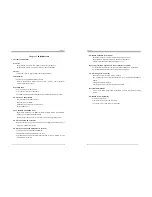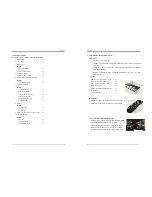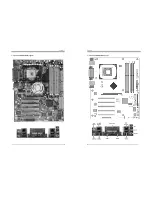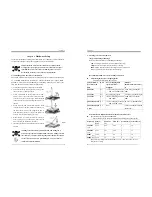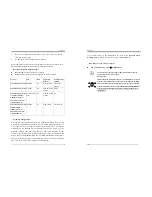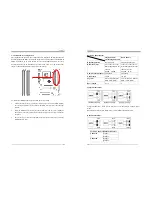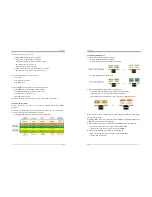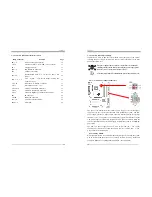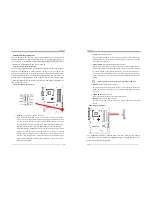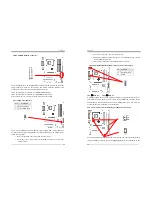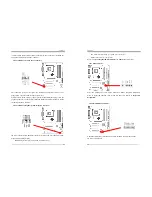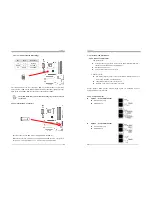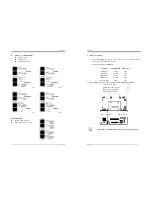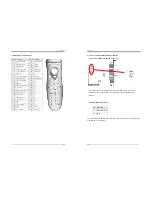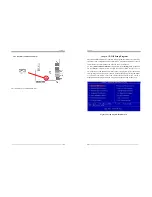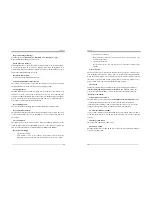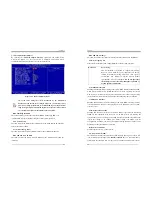
Chapter 2
7
Chapter 2
Hardware Setup
If your motherboard has already been installed in your computer you may still need
to refer to this chapter if you plan to upgrade your system's hardware.
This motherboard is electrostatic sensitive. Do not touch without
wearing proper safety gadget and make sure to disconnect the power
cable from the power source before performing any work on your
motherboard. Not doing so may result in electrical shock!
2-1 Installing a CPU Processor for Socket 478
The Intel® Socket 478, designed for the Pentium 4 processor, has been incorporated
as a standard motherboard specification. This motherboard will support Intel®
Pentium 4 CPUs with its embedded Hyper-Threading technology. To insert your
CPU into Socket 478 please follow the steps below:
1. Locate the 478-pin CPU socket on the motherboard.
2. Unlock the socket by pressing the lever sideways, and
then open it up to a 90-degree angle.
3. Locate a Gold Mark on the top surface of the CPU,
which is close to one of the CPU corners. The same
corner will also be cut off, leaving a noticeable notch
in the CPU's corner. These markings indicate Pin 1 on
the CPU.
4. Gently insert the CPU with Gold Mark/Pin 1 at the
same corner of Socket 478, which is located close to
the end of the lever. Allow the weight of the CPU to
push itself into place. Do not apply extra pressure as
doing so may result in damaging your CPU.
5. When the CPU is correctly inserted, close the lever
with your finger on to of the CPU to make sure the
CPU is properly embedded into the socket.
6. Insert an appropriate heat sink and fan for proper Heat
dispatch.
Installing a standard Intel® specified heat sink with cooling fan is
necessary for proper heat dissipation from your CPU. Failing to install
these items may result in overheating and possible burnout of your CPU.
In order to boot up with a newly installed CPU, AC Power must be
switched off before installation.
Chapter 2
8
2-2 Setting your CPU’s Parameters
“Hyper-Threading Technology”
Basic requirements for Hyper-Threading Technology:
CPU:
An Intel® Pentium® 4 Processor with HT Technology;
Chipset:
An Intel® Chipset that supports HT Technology;
BIOS:
A BIOS that supports HT Technology and has it enabled; and
OS:
An operating system that supports HT Technology.
Boxed Intel Pentium 4 Processor naming convention
Letter Designators for overlapping speeds
- This
data
not
reflected in Spec Update
Intel Pentium 4
Processor with
FSB
HTT
For overlapping FSB
speeds uses letter
designator
Example
Intel Pentium 4 Processor
at
800 MHz
Yes
“C”(if overlapping with 500
MHz or 400 MHz FSB)
2.40C GHz (w/800MHz
FSB)
533 MHz
Yes
No overlapping speeds
3.06 GHz (w/533MHz FSB)
533 MHz
No
“B”(if overlapping with 400
MHz FSB)
2.40B GHz (w/533MHz
FSB)
400 MHz w/512K
No
“A”(if overlapping with 400
MHz w/256K cache)
2A GHz (w/ 400MHz FSB)
400 MHz w/256K
Cache
No
None
2 GHz (w/400MHz FSB and
256K cache)
Electrical/Power Requirements for the Intel Celeron Processor
Specifications for Celeron 400 MHz FSB
- See the latest Celeron Processor EMTS for specifications on other speeds
Frequency VID (V)
Max
ICC Max
(A)
TDP (W)
Tcase Min(C) Tcase Max(C)
2.30 GHz
(1,3)
1.525 49.2 58.3 5
70
2.40 GHz
(1,3)
1.525 50.7 59.8 5
71
FMB1
(1,3) 1.525 60
64 5
70
FMB2
(2,3) 1.525 70
82 5
70
1. This
processor
will ship under multiple VIDs of 1.475, 1.500, and 1.525 with 1.525
being the max voltage.




